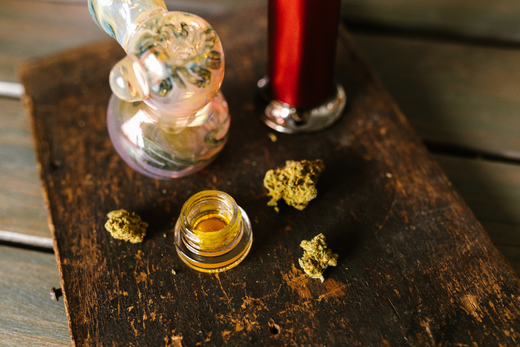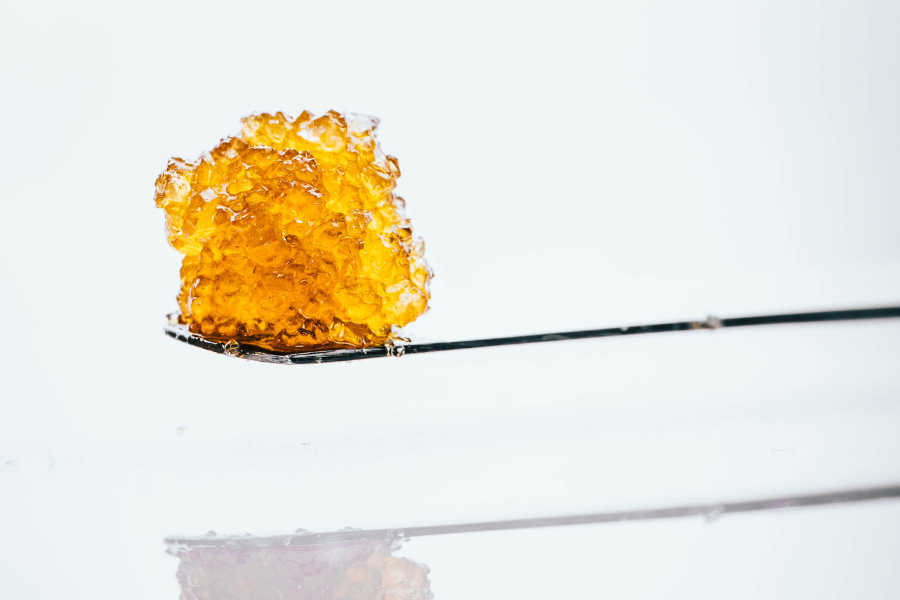
The world of cannabis concentrates is complex with so many different options at your fingertips. From wax to rosin, live resin to distillate, it’s easy to get overwhelmed.
The differences will be fairly negligible to the casual consumer. True connoisseurs or those aspiring to experience all that cannabis has to offer, though, recognize that the nuances between live resin vs rosin vs distillate are more substantial though.
That’s why we put together this comparison of distillate vs live resin vs rosin. While each has its place, live resin and live rosin are in an entirely separate category from distillate. Frankly, the only similarity distillate has with the other two is that it’s a form of cannabis extract.
That being said, live resin and rosin are full-spectrum extracts that produce a far more true-to-strain experience. Distillate isolates cannabinoids for a flatter, more one-dimensional high.
There’s a lot to unpack in comparing live resin vs distillate vs rosin, but just know this: you can’t beat the premium experience live resin and rosin have to offer. Our live resin gummies and live rosin gummies are the pinnacle of cannabis products, see why today!
What Is Live Resin?
So what are live resin gummies exactly? This cannabis concentrate is carefully crafted by flash-freezing fresh cannabis flowers at harvest and extracting the plant's chemical profile through solvents like butane or carbon dioxide.
This begs the question, is live resin dangerous? Not at all! The purging process after the fact removes any residual solvents for the purest concentrate possible. This can be confirmed through lab testing so you can indulge with peace of mind.
This concentrate is named after the fresh - or live - cannabis flower it’s extracted from. This unique approach retains the natural terpenes, flavonoids, and other compounds that not only produce that coveted high but all sorts of other therapeutic benefits.
This is also known as “the entourage effect.” It basically states that cannabis is best consumed as nature intended, with all the moving parts enjoyed together - rather than stripped away and isolated.
For instance, CBD can prevent some of the infrequent side effects of THC, such as increased hunger and anxiety, by preventing THC from interacting with receptors in the body.
Studies have shown that consuming CBD, terpenes, and flavonoids together (as found in live resin or rosin products) may even support better pain reduction and anti-inflammatory effects than CBD alone!
That being said, are live resin gummies stronger? Some certainly feel that they are, but this just goes back to the entourage effect. You’ll feel a more balanced, complex high as opposed to a simple distillate that contains only THC.
Live resin products are also known for superior aroma and flavor since they are packed with the strain’s true terpene and flavonoid profile. Many prefer live resin vs distillate for this exact reason - it tastes and feels similar to smoking actual flower.
What Is Rosin?
Rosin is another premium extract that falls under the “solventless” umbrella. Instead of relying on butane or CO2 to separate the good stuff from the plant matter, rosin quite literally squeezes everything out.
The process is far more labor-intensive, which means it can be more expensive. The plant matter is placed in an ice bath and then filtered through a series of various-sized micron bags. What you’re left with is basically just the trichomes, which contain not only THC but all other cannabinoids, terpenes, and flavonoids. This is known as bubble hash.
The dried bubble hash is then put into a “rosin press,” which uses a combination of heat and pressure to form a concentrated extract containing all the best parts of cannabis in its purest form. No need to worry about purging, that rosin can then be used for dabs, gummies, or vapes.
Now, it’s worth noting that there is a subcategory here known as live rosin. Not all rosin is made this way, but live rosin starts with the very same process as live resin in that it’s made from flash-frozen flowers immediately post-harvest.
This is considered the gold standard in cannabis concentrate, and it’s a form of extract we’re proud to use for our hybrid gummies, indica gummies, and sativa gummies here at Evn. More on that in a moment - let’s introduce the final piece of the live resin vs rosin vs distillate puzzle.
What Is Distillate?
Distillate is a potent cannabis concentrate, but don’t mistake potent for premium - this is the lowest form of concentrate you can get your hands on.
It’s created when a cannabinoid, most often THC or CBD, is extracted and isolated from plant compounds. It’s versatile, strong, and one of the most common cannabis concentrates available today. That’s because it’s really cheap to make.
Dried and cured cannabis is extracted into oil, which is then distilled through a process that vaporizes crude cannabis oil. High heat is used to separate the cannabinoids from other plant materials and compounds.
The end result is a nearly translucent, tasteless, and odorless liquid that can then be used in edibles and vape cartridges. However, this THC isolate isn’t going to produce anything remotely close to the effects of live resin or rosin.
Again, this is because of the entourage effect. Even at something ridiculous like 90%+ THC per gummy or vape pen, the high will feel boring, lackluster, and one-dimensional. That’s because you’re not getting CBN, THH, CBG, or any other secondary cannabinoids that round out the effects of cannabis.
But you’re also missing terpenes and flavonoids. Not only do these compounds bring aromatic and flavor profiles to the fun, but they shape effects as well. Further to that point, manufacturers have to then add terpenes and flavonoids after the fact.
Most of the time those terpenes aren’t going to be true to strain, they’ll be chosen based on some sort of generic flavoring. In other cases, they’ll be true to strain - but synthetic. At any rate, you’re not getting the authentic cannabis experience you deserve.
Live Resin vs Rosin vs Distillate: Where Does Each Have an Edge?
You’re probably starting to get a better sense of where live resin vs rosin vs distillate differ just based on our breakdown of what goes into each form of extraction.
But there is so much nuance in comparing distillate vs live resin vs rosin that we want to take a closer look at where each has an edge so that you can feel more confident choosing the right products based on your personal preferences. Let’s start with what matters most: effects.
Potency and Effects
We want to make it clear that potency and effects are two very different things. Potency speaks to how strong a high is, but when we talk about effects, we’re looking at the high holistically and thinking about how balanced and well-rounded it is.
Live resin is going to be the best all-around concentrate in terms of effects since it’s as true-to-strain as you’ll get. It delivers the most nuanced high of all three forms.
That being said, rosin is a close second - and when we’re looking specifically at live rosin, it’s right there with live resin, sometimes even outperforming it depending on the cultivar and extractor.
Distillate is undoubtedly the strongest in terms of potency since it has the highest THC percentage, but who cares if the high is one-dimensional and boring? Without secondary cannabinoids, terpenes, and other compounds, it will feel flat and lack complexity.
Flavor and Aroma
True connoisseurs appreciate everything the plant has to offer - not just its effects but also its flavor and aroma. Live resin is bursting with flavor and aroma since it preserves the plant’s true-to-strain terpene and flavonoid profiles.
But as a solventless extract, rosin is as pure as it gets. This shows in terms of taste and smell. It’s super clean, and live rosin especially is considered the gold standard in flavor and aroma.
Distillate, on the other hand, is both tasteless and odorless. You can think of it as pure THC with nothing more to offer. Boring! Even when it does have terpenes and flavonoids added after the fact, these are often synthetic or generic, leaving the experience feeling artificial and lackluster.
Versatility
Maybe you’re wondering how to make live resin gummies, or you want to know if you can smoke live resin. This concentrate is among the most versatile you can get your hands on - edibles, vapes, dabs, or even tinctures are all options.
Rosin shares similar versatility but is mostly used for dabbing and edibles due to its solventless nature. Distillate is perhaps the most versatile between live resin vs rosin vs distillate, but this comes at the cost of flavor and the overall experience.
Cost
Now, there is one aspect where you’ll see an edge for distillate vs live resin vs rosin: it’s as cheap as it gets. This is because you’re getting what you pay for. It’s widely available and affordable, but it falls short in just about every other aspect aside from versatility.
That’s to say that live resin and rosin are both viewed as premium cannabis concentrates, with prices to match. The labor-intensive extraction processes and more enjoyable experiences they have to offer are worth every penny in our book!
Bringing Our Comparison of Distillate vs Live Resin vs Rosin to a Close
That does it for our comparison of live resin vs rosin vs distillate. The key takeaway is that while each has its place, distillate is not in the same league as these more premium forms of extract. It’s the cheapest option for a reason.
For a more well-rounded, true-to-strain experience, we recommend choosing either live resin or rosin (ideally live rosin). There are other forms of extract to consider as well, including live resin vs liquid diamonds, live resin vs wax, and live badder vs live resin.
But whether you’re looking for CBN THC gummies or even a THC tincture, head over to Evn and spoil yourself with the cleanest, most cannabis products available online, 100% legally.
We bring the flavor and the effects straight to your doorstep with products sourced from the most elite, ethical farms in the country. All our products are made from live resin or live rosin because we don’t believe you deserve anything less than the best.
So, taste and experience the difference between distillate vs live resin vs rosin today - you’ll see why the other two are much more sought after than distillate once you do!


